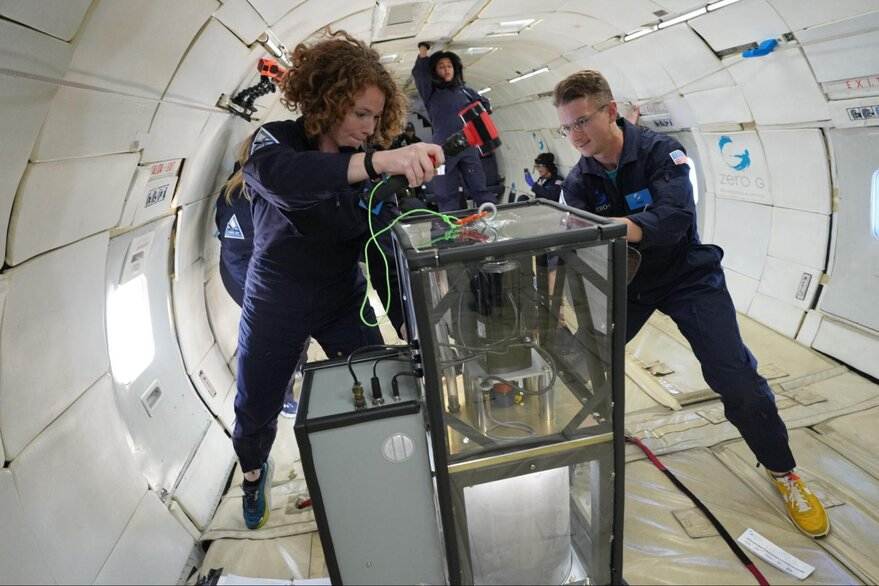Interlune reveals details of quest to bring home lunar resources

Technology tamfitronics
SAN FRANCISCO – Without context, Interlune’s plan to extract Helium-3 from lunar regolith to fulfill terrestrial demand sounds improbable. Even Interlune co-founder and chief technology officer Gary Lai was skeptical initially.
“Then, I started doing engineering analysis and we started talking to customers,” Lai, former Blue Origin chief architect, told SpaceNews. “It took probably six months before I realized this was a real thing, and something that no serious organization was going after.”
Seattle-based Interlune was founded in 2020 by Lai, former Blue Origin President Rob Meyerson, Apollo 17 astronaut and geologist Harrison Schmitt, Indra Hornsby, former Blacksky and Spaceflight Industries general counsel, and James Antifaev, former Spaceflight director for new and emerging markets.
In a Sept. 10 blog post, Lai reveals details of Interlune’s plan for robotic collection and automated processing of regolith. Supplying Helium-3 to terrestrial markets in the 2030s is the first step. In the long run, the startup aims to “harvest other resources such as industrial metals, rare Earth elements, and rocket propellant to support a long-term presence on the Moon and a robust in-space economy,” according to the blog.
“We are looking at this as a long-term opportunity,” Rob Meyerson, Interlune co-founder and CEO, said in July at the AIAA ASCEND conference in Las Vegas.
For now, Interlune’s staff of around 20 focuses on prototyping hardware to address the myriad challenges of digging up regolith, processing it in a power-efficient way, off-gassing solar wind volatiles and isolating Helium-3.
“Today, we’re building sub-scale models of excavator concepts and testing them with regolith simulants to measure power consumption and performance,” the blog said. “We’ll build full-scale prototypes later this year.”
It’s important to note that Helium-3 concentrations in lunar regolith are likely to fall somewhere between one part in 3,000 and one part in 10,000, Lai said.

Quantum demand
Interlune will start by collecting “very small quantities of Helium-3,” Lai said. “We’re only talking about returning single digit to 20 kilograms of product back to Earth within the early years of our operation.”
On Earth, Helium-3 has applications for quantum computing, fusion-power research, medical imaging and radiation detection, at border crossings for example.
The quantum market “was the critical piece” of the business case, Lai said. “If you had Helium-3 today, the customers would buy it at $20 million a kilogram in a quantity large enough to make a profit.”
Plus, supplying 20 kilograms of Helium-3 is “not going to collapse the global market price,” Meyerson said. “Demand is going up. Quantum computing companies have very specific targets over the next two, five, 10 years to double the number of qubits, double the size of devices and double the number of devices.”

Risk mitigation
Two upcoming Interlune demonstration missions are on the horizon.
In a 2027 mission, Interlune “will focus on validating the concentration of Helium-3 and other solar wind volatiles at a potential future harvesting site, evaluating the site for operations, and demonstrating Interlune’s proprietary extraction technology in the lunar environment,” the blog said. “Interlune is currently designing this mission, evaluating commercial landers, and entertaining research collaborations.”
Interlune then plans to establish in 2029 a lunar pilot plant “to prove out every step” including “returning meaningful quantities of Helium-3 to our customers for a fraction of the launch mass and cost,” the blog said.
Sophisticated technology will be required. Interlune’s Helium-3 harvester, for instance, “will use vision sensors and ground-penetrating radar to determine the optimum harvesting route plan,” the blog said. “A robotic arm will move surface rocks that are too large to process. The harvester will alter course or pause excavation to get around obstacles that are too large to move or beneath the surface.”
Public and private funding
Interlune announced an $15 million seed funding round in March led by Seven Seven Six, an early stage venture capital firm.
By backing Interlune, “we’re investing in the future of energy and the in-space economy,” Katelin Holloway, founding partner. “One of those alone would be highly compelling, but when you marry them together with this particular group of people, it is pretty phenomenal.”
In July, NASA’s TechFlights program gave a $348,000 grant to pay for testing of Interlune’s regolith-processing technology on Zero Gravity parabolic flights. Initial tests of an Interlune prototype device flew on a Zero Gravity flight in February.
Under the recent award, Interlune will test extraction technology with “regolith simulants processed in a vacuum,” the blog said. “We will analyze trade-offs in size, weight, and power required for different performance levels using parabolic flights. Interlune will use the results to plan for scaling its technology to handle multiple tons of regolith.”
The National Science Foundation awarded Interlune a $246,028 grant in 2023 “to develop and demonstrate a novel regolith size sorting system for use on the Moon that has 10x smaller volume, 5x lower mass, and greater reliability than traditional devices,” according to the award abstract.
“At this point, only a small portion of our cash comes from grants,” Lai said. “But the grants provide a signal that that is not a completely commercial interest. There is legitimate government interest in what we’re doing.”
Skating ahead
Interlune founders are counting on others to transport their technology to the moon.
“We built Interlune with the idea that NASA’s Artemis program is here to stay,” Meyerson said. “That will provide us with the small cargo, heavy cargo and mobility infrastructure that we need.”
Technology demonstration missions, for example, will fly on Commercial Lunar Payload Services flights. Interlune is talking to companies CLPS mission providers but has not announced any agreements.
“We are very confident that the Human Landing System, Starship and Blue Origin landers will come to market,” Lai said. “They will probably be commercially available towards the end of the decade.”
To achieve its goal of being the first to market with Helium-3 drawn from lunar regolith, Interlune has work to perform on the ground and the lunar surface.
“There is a certain amount of development that is required on core technology for Helium-3 extraction that we want to do in parallel, so that we’re ready for the infrastructure that the Artemis program and the other commercial providers are putting in place,” Lai said.
Interlune called the blog post “a small peek into our plans to harvest natural resources from space,” noting that it was too soon to share other details.
“But we hope this summary helps build excitement and conviction around the Interlune mission to lead the world in sustainable, responsible harvesting of natural resources from space to benefit humanity,” the blog concluded.
Correction: Interlune raised $15 million in a seed funding round in March.
Discover more from Tamfis Nigeria Lmited
Subscribe to get the latest posts sent to your email.



 Hot Deals
Hot Deals Shopfinish
Shopfinish Shop
Shop Appliances
Appliances Babies & Kids
Babies & Kids Best Selling
Best Selling Books
Books Consumer Electronics
Consumer Electronics Furniture
Furniture Home & Kitchen
Home & Kitchen Jewelry
Jewelry Luxury & Beauty
Luxury & Beauty Shoes
Shoes Training & Certifications
Training & Certifications Wears & Clothings
Wears & Clothings
















